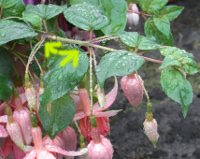Once a plant stem 'decides' to flower, the apical meristem, contained within the terminal bud (growing tip), ceases laying down only dormant side shoots in new leaf axils and begins to produce flowers (or flowers and shoots). At this time, it ceases to be called an 'apical meristem' and becomes instead a 'floral meristem'. However, this change is not obvious; it only becomes apparent once flower buds can be seen. Until this time, it appears like a normal shoot tip, the young flower buds being there but too small to detect. So this is what has happened here. This change into flowering mode had occurred in two cuttings only. The third was a normal stem.
FUCHSIAS LAY DOWN FLOWERS IN DIFFERENT WAYS
SELF-BRANCHING TYPES

 The situation is even more confusing in fuchsias because some continue to lay down both flowers and shoots in their leaf axils. 'Genii' (left) lays down flowers (pink) and shoots (lime) at DIFFERENT nodes, whereas 'Hawkshead' (right) lays down both flowers and shoots at the SAME (but not all) nodes. These young dormant axillary shoots, once activated, allow these fuchsia stems to become 'self-branching', thereby developing the shrub vegetatively as flowering continues throughout the summer.
The situation is even more confusing in fuchsias because some continue to lay down both flowers and shoots in their leaf axils. 'Genii' (left) lays down flowers (pink) and shoots (lime) at DIFFERENT nodes, whereas 'Hawkshead' (right) lays down both flowers and shoots at the SAME (but not all) nodes. These young dormant axillary shoots, once activated, allow these fuchsia stems to become 'self-branching', thereby developing the shrub vegetatively as flowering continues throughout the summer.
NON-SELF-BRANCHING TYPES
 Some fuchsias, however, once flowering has begun, cease laying down side shoots and lay down only flower buds (plus a pair of feeder leaves) in the axils of each consecutive new node. This continues for a few weeks until flowering has finished, at which time vegetative growth resumes, followed by another flush of flowers. Thus, the shrub stops developing during flowering, so must be built up previously. However, there is a plus in that the flowers are more visible (and therefore look more spectacular) because they are not covered by leaves, thereby making these plants more suitable for exhibition purposes. Note that 'Amazing Maisie' (left) produces two pairs of flowers at each node, along with two feeder leaves. This has the effect of making the plant appear more floriferous; it also makes it easier to shape for best effect.
Some fuchsias, however, once flowering has begun, cease laying down side shoots and lay down only flower buds (plus a pair of feeder leaves) in the axils of each consecutive new node. This continues for a few weeks until flowering has finished, at which time vegetative growth resumes, followed by another flush of flowers. Thus, the shrub stops developing during flowering, so must be built up previously. However, there is a plus in that the flowers are more visible (and therefore look more spectacular) because they are not covered by leaves, thereby making these plants more suitable for exhibition purposes. Note that 'Amazing Maisie' (left) produces two pairs of flowers at each node, along with two feeder leaves. This has the effect of making the plant appear more floriferous; it also makes it easier to shape for best effect.
No comments:
Post a Comment